The ballad about the "damned rifle". It all started with a jet bullet
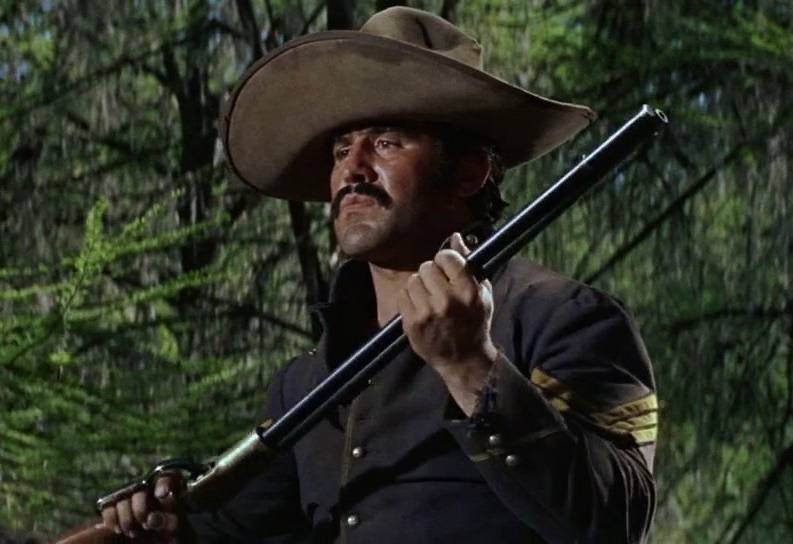
Poison gruel with me
And right after dinner
I'll sing you about weapon,
Weapon, weapon ballad.
Vladimir Vysotsky. Ballad of weapons
Weapons and firms. If we open the book by V.E. Markevich "Hand firearms" (that is, the "Bible" of anyone who is interested in history weapons), then we can read there that in the 1850s the gunsmith Wesson in the United States patented a repeating pistol of the magazine system of the most original device called Volcanic (patent February 14, 1854). And then in the same year he also released a carbine of the same device, and for exactly the same extremely specific ammunition. And that with this weapon the history of the well-known carbine and Winchester rifle began just then.
But delving deeper into history, we can also find out what Markevich for some reason did not write about, but which is directly related to Volcanik. Namely, what served as its basis. And it turns out that this whole story of the lever action rifle began much earlier, and in addition not with Mr. Wesson, but with a man from New York named Walter Hunt.
And he, having conceived to create a rifle, which had not yet seen the world, decided that (before he could make it) he would need a cartridge for it. And so it was in 1848 that he proposed the world's first bullet-cartridge called "Rocket Ball". Its cavity was filled with gunpowder, which was held inside by a cardboard disc with a wax hole for ignition.
Yes, yes, Hunt's bullet did not have its own primer! But his rifle, which had a very strange name - "Desire", was the first in the world equipped with an under-barrel tube magazine, in which one after another could fit as many as 12 bullets.
By the way, Walter Hunt himself made many wonderful inventions in addition to this rifle. Moreover, they have largely determined the appearance of our modern world. Because among them we have a shuttle sewing machine, a safety pin, a snow plow and much more.
The “Desire” rifle, as noted above, had a tubular magazine mounted under the barrel, and it used a lever mechanism to move cartridges from it to its breech. But the cartridges she fired did not have primers that the shooter had to manually set for each shot, as was the case with the muzzle-loading rifle. Thus, although the Hunt rifle was a step forward towards the magazine rifle, its design still needed significant improvement.
Lewis Jennings also decided to work on improving the Hunt rifle to automate the charge initiation system and make it a real magazine rifle. It was then that Horace Smith joined him, who later became one of the founders of the Smith & Wesson company. Jennings and Smith were at the time at Robbins & Lawrence. And at the same time they were joined by another legendary person - Benjamin Tyler Henry, who at that time worked at Robbins and Lawrence as a shop foreman.
This rifle has two magazines.
One for “Rocket Ball” cartridges without primer. And in the upper part there is a store for primers. When you switch the lever, a new cartridge from the tubular magazine under the barrel will be inserted into the chamber, and at the same time the primer will be fed into the hole at the top of the breech.
An improved version soon appeared, which became known as the Smith-Jennings rifle. But, nevertheless, it did not become a "cult weapon".
Daniel Wesson came to Robbins & Lawrence in 1850. The whole team began to think about how to improve Hunt's Rocket Ball and his Desire rifle.
The following year, 1851, the Robbins & Lawrence Company decided to send Horace Smith to the Great British Exhibition, which was held in London's Crystal Palace in modern Hyde Park. At the exhibition, Smith met Louis Flaubert, the inventor of the rimfire cartridge, which later became the first truly practical unitary cartridge, which was then successfully used in precisely rifles with a lever mechanism.
On their return to the United States, Horace Smith and Daniel Wesson came up with a new cartridge that was very different from Flaubert's rimfire cartridge, so as not to infringe on his patents.
In the design of the Smith and Wesson cartridge, the initiating compound was located between two metal discs, and the impact of the striker on them could cause its ignition. In fact, they came up with the world's first caseless cartridge, and then created a pistol and carbine for it.
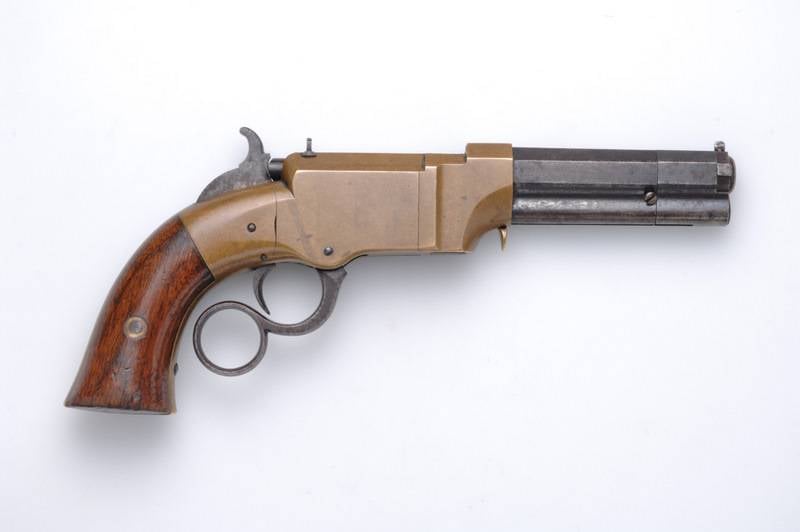
Exterior (photo courtesy of Alain Daubresse)
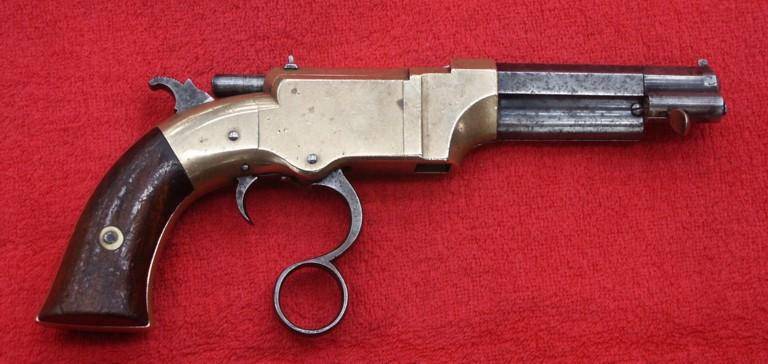
Volcanic on reloading (photo courtesy of Alain Daubresse)
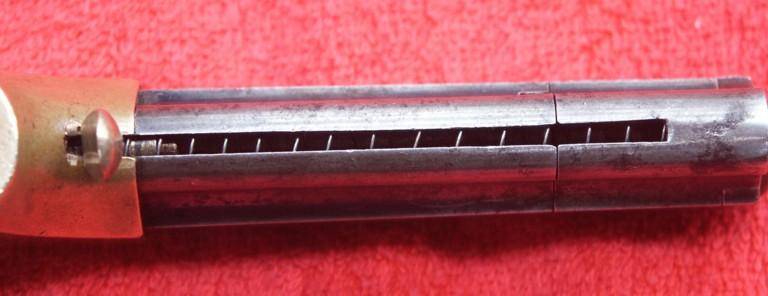
The slot in the magazine along which the cartridge pusher moves. (Photo courtesy of Alain Daubresse)
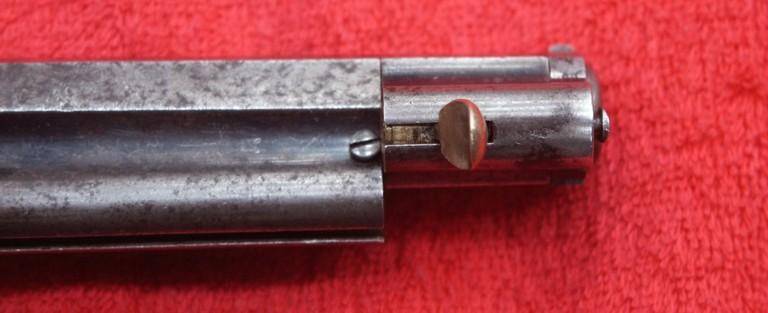
The pusher lever retracted into the rotary clutch until it stops before filling the magazine with cartridges (photo courtesy of Alain Daubresse)
Smith and Wesson patented their cartridge and lever action rifle designs in 1854, but the first examples of these cartridges were made by hand.
It turned out that at that time there was simply no technology for the mass production of cartridges of this design, so their production was very expensive. Despite this, Smith and Wesson released several models of pistols with a lever mechanism and an underbarrel magazine for this ammunition, and Tyler Henry, who worked with them, used them for his rifles, with a bolt controlled by a lever bracket, which in the end is so "Henry's bracket" and named.
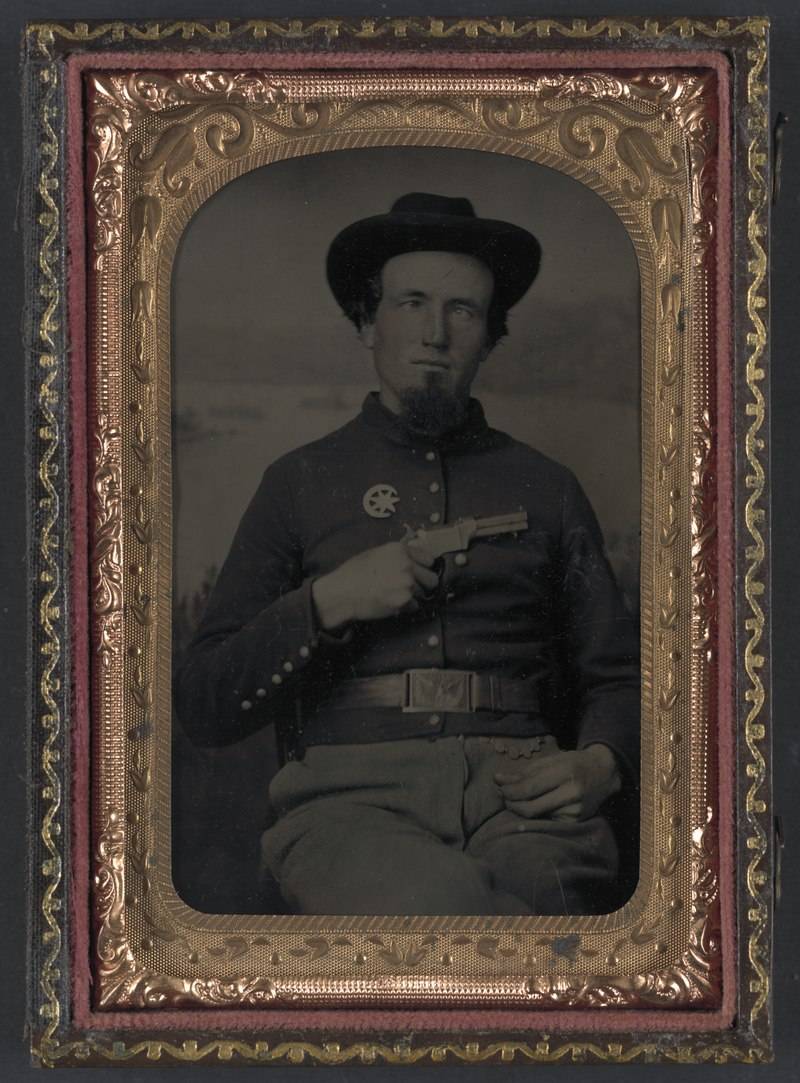
An absolutely unique photograph. It shows a Northerner soldier of the 7th Corps of Arkansas holding a Volcanic pistol in his hand. That is, a certain number of them even ended up in the American army, although they were never standard weapons. Library of Congress
However, the Volcanics, as they say, did not go either in the pistol version or in the carbine version.
There were several reasons. This is the weak impact force of a 10-mm rocket bullet, and the need to operate with the left hand when reloading, which was not very convenient. And besides, this weapon turned out to be simply dangerous for the shooter, since there was a danger of impaling the primer with the tip of the previous bullet. In this case, the store just exploded. And if in the case of a pistol it was somehow possible to survive, then such an explosion in the magazine of the carbine (especially when holding it with the left hand) would have fatal consequences, both for the weapon itself and for the shooter.
Today, only three carbines are known for such "caseless cartridges". One is in the Bill Cody Firearms Museum and the other two are in private hands. One of them was put up for sale at the Rock Island Auction, May 22-24, 2020.

Smith and Wesson carbine for caseless cartridges from Rock Island Auction. The peculiarity of this carbine was that its main trigger guard was attached to the receiver, and the lever was a separate part and was "wrapped" around it. On the left side of the stock is engraved with a "good handshake". It is likely that it symbolized the partnership between Horace Smith and Daniel Wesson. (Photo from revivaler.com)
What then is Tyler Henry? What role did he play in all this and what exactly did he do? Let's start with his biography.
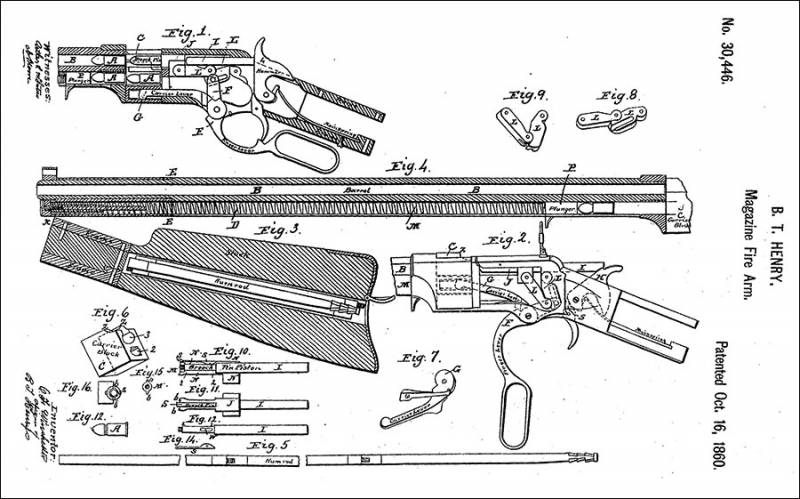
Schematic diagram of the Henry rifle. Its lever mechanism for controlling the shutter and the cartridge feed tray is very clearly shown, as well as the U-shaped shutter with two strikers at once to increase the effectiveness of the effect on the initiating charge in the rim of the cartridge case. And where is the ramrod, after all, you can't do without it with black powder cartridges? And the ramrod of this rifle was assembled, screwed. And it was kept in her butt.
Benjamin Tyler Henry (March 22, 1821 - June 8, 1898) was born in Claremont, New Hampshire in 1821. As a young man, he studied with a gunsmith and worked his way up to master at the Robins & Lawrence Arms Company in Windsor, Vermont, where he worked with Horace Smith and Daniel B. Wesson to improve the rifle known as the Wish.
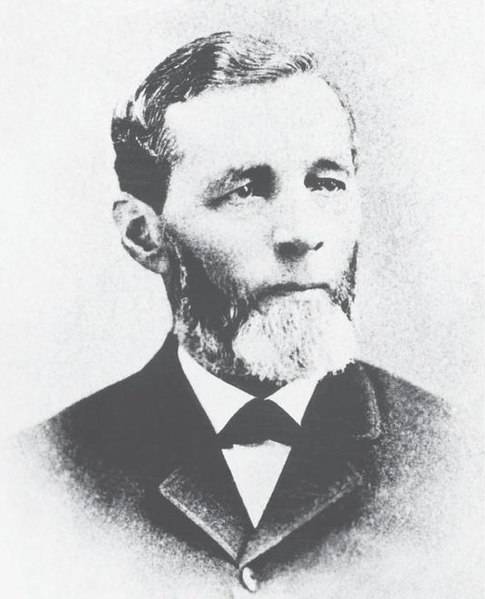
Portrait of Benjamin Tyler Henry
In 1854, Horace Smith and Daniel B. Wesson, together with Cortland Palmer, founded a new company and improved the working mechanism of this rifle and developed the Volcanic pistol on its basis.
Its production was established in the workshop of Horace Smith in Norwich (Connecticut). The original name "Smith & Wesson Company" was changed to "Volcanic Repeating Arms Company" in 1855. Simultaneously with the attraction of new investors, one of which was Oliver Winchester.
The Volcanic Repeating Arms Company received all rights to the Volcanic design (by that time both pistol and carbine versions were produced), as well as ammunition from Smith & Wesson. Wesson himself remained the plant manager for eight months, after which he again took part in Smith, and they created a new company, Smith & Wesson Revolver Company.
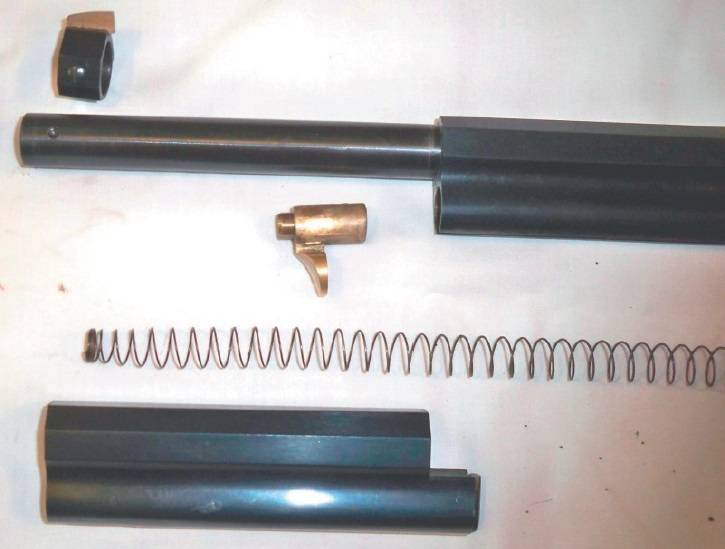
Henry's rifle charging assembly. Photo of Stones River Bettlefield National Park. Tennessee
Perhaps this was the most original part of this rifle.
The octagonal barrel was round at the end. And on this part, a clutch was put on, which was engaged with the under-barrel magazine. It was necessary to move the spring into it using a lever on the cartridge pusher, which moved along the groove throughout the store, and then turn it to the side. The magazine tube thus opened and it was possible to insert cartridges into it: one by one, bullets forward. Then the clutch returned to its place, the spring with the pusher was released, the pusher pressed on the cartridges. When working with an underbarrel lever, they were fed to the tray, raised to the level of ramming and then pushed by the bolt into the chamber, after which it was possible to shoot from the rifle.
The bad thing was that the pusher lever, when firing, often rested against the shooter's hand, which led (if he did not notice this in the heat of battle) to delays in firing due to the failure to supply the next cartridge.
Only now they began to produce already revolvers, having bought from Rollin White his patent for a through drum.
But Winchester at the end of 1856 bankrupted the Volcanic Arms company, and then he himself bought it, but transferred production to New Haven (Connecticut), where in April 1857 he created his own company, New Haven Arms Company. He hired Tyler Henry to manage the business and gave him a good salary.
On October 16, 1860, Henry received a patent for a .44-caliber magazine rifle, which no longer fired caseless ammunition for the Volcanic, but sidefire cartridges. Moreover, the first Henry's rifles were then very expensive - $ 50 a piece (a three-month soldier's salary!), So they were not produced for use in the army until the middle of 1862.

Henry Rifle Model 1860, .44 caliber, manufactured by New Haven Arms Company. National Museum of American History. Washington
In 1864, Henry became angry with Winchester (due to insufficient compensation for his labor) and tried to get the Connecticut legislature to transfer ownership of the New Haven Arms to him.
Oliver Winchester, who hastily returned from Europe, got ahead of the move and reorganized New Haven Arms into the Winchester Repeating Arms Company. And then Winchester completely modified and improved the basic design of the Henry rifle.
Transformed it into Winchester's first rifle, the Model 1866, which fired the same rimfire .44 caliber rounds as Henry's rifle, but with an improved magazine. And, most importantly, it received a "hatch" on the right side of the receiver for loading cartridges into it. Moreover, it is clear that Winchester did not come up with this innovation himself. And he took advantage of the development of his employee Nelson King. (Because of what, by the way, this detail was nicknamed "the royal innovation"). Also in this model, a wooden fore-end was used for the first time, which made this weapon truly comfortable.
As a result, Henry was offended.
He left the Winchester Repeating Arms Company. And then he worked in his private workshop as a gunsmith until his death in 1898.
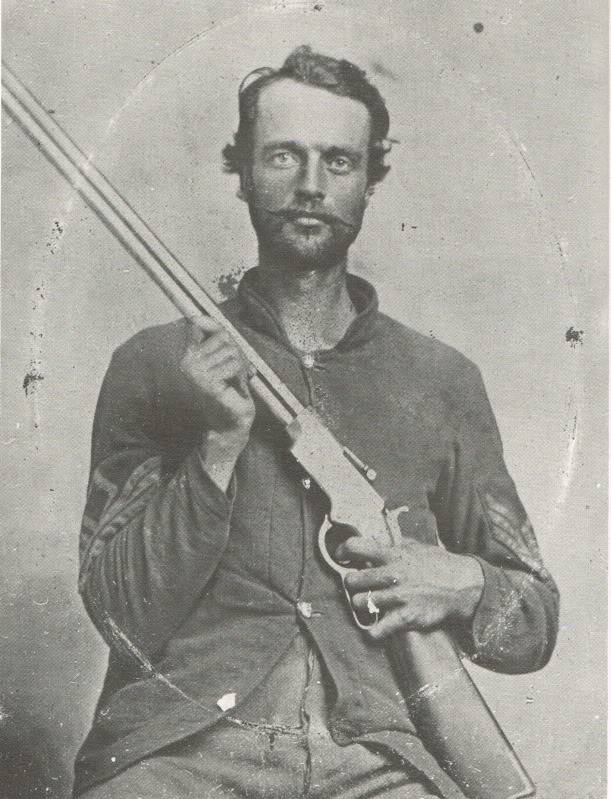
Northerner soldier with Henry rifle in hand. Library of Congress
So, as you can see, he did not do that much. He just envied how much of his simple improvement was squeezed out by his cunning boss!
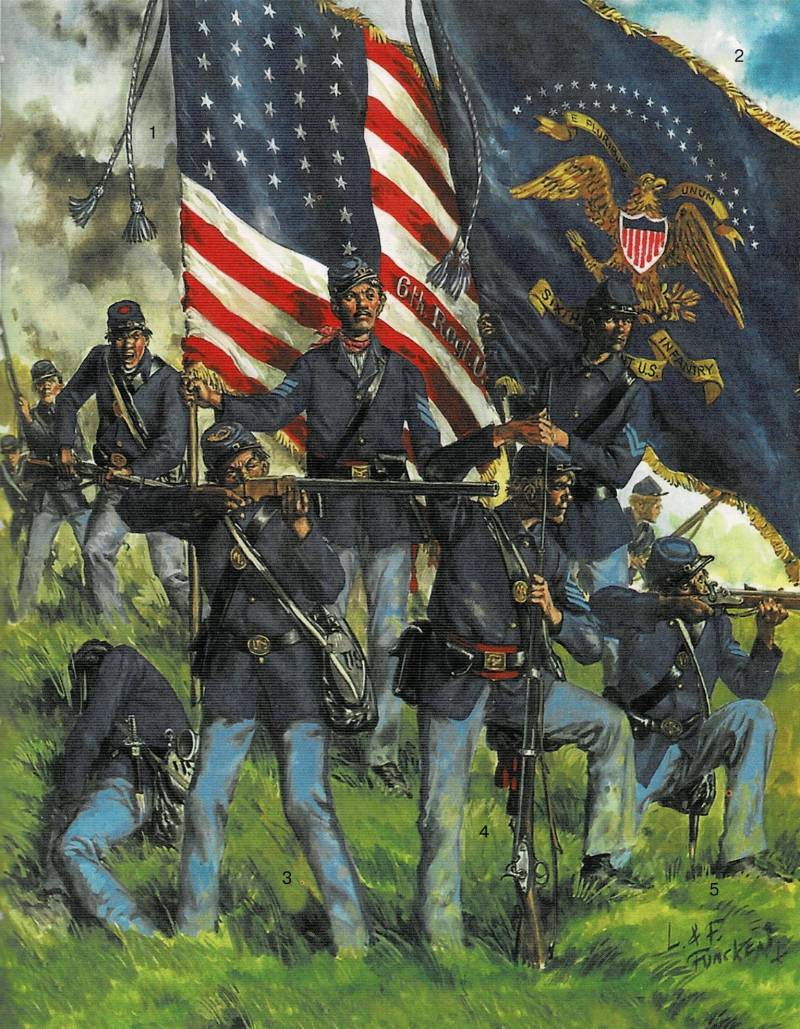
Northerner soldiers in battle. Soldier number 3 is armed with a Henry rifle. Usually, soldiers with such rifles were assigned to guard the regiment's banner! Illustration by Liliana and Fred Funkenov from the book “Encyclopedia of Weapons and Military Suit. Wars on the American continent of the 2003th – 111th centuries. M .: AST / Astrel, XNUMX S. XNUMX
Nevertheless, his 15-round rifle made history in the US Civil War.
The 7th Illinois Volunteer Regiment was armed with it and compared to other units (still firing from muzzle-loading primer rifles) was considered almost the most "killer" unit of the Northern army.
Southerners called her
and the advertisement claimed that
Of course, this was an exaggeration.
But the fact that it could be fired 15 shots in 30 seconds is beyond doubt. Whereas primer rifles gave a maximum of two rounds per minute.
To be continued ...

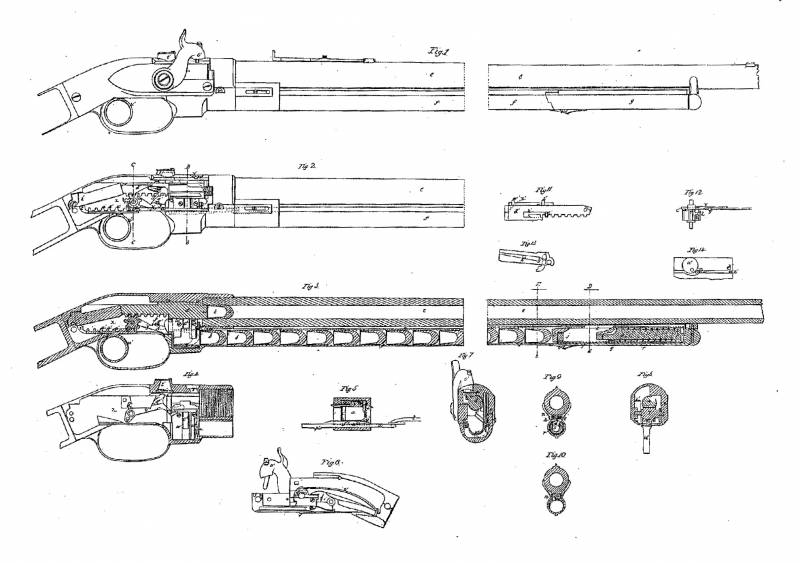
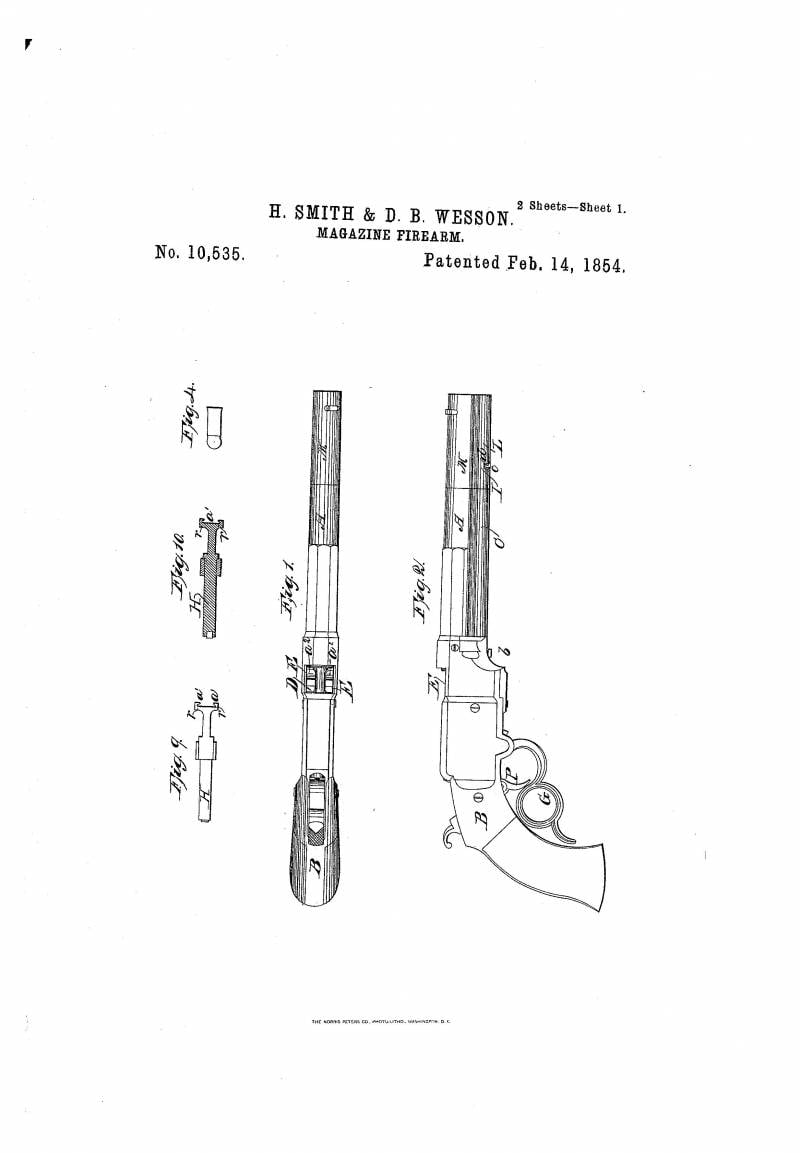
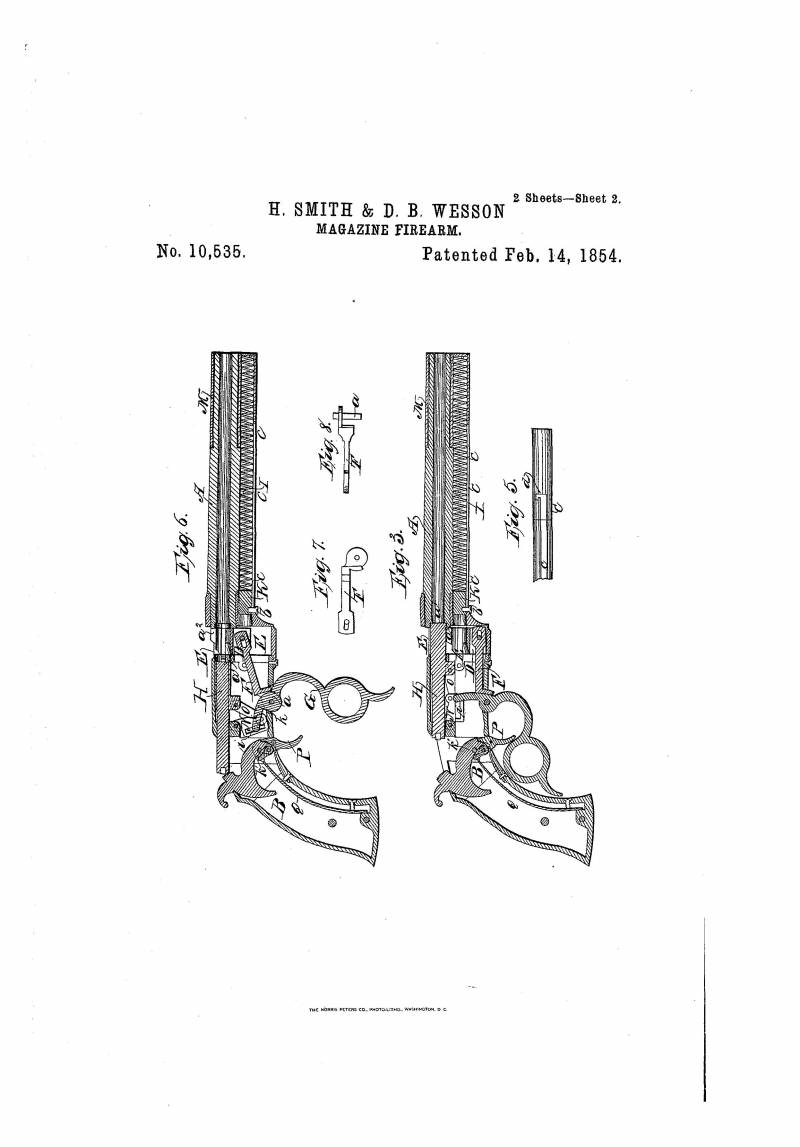
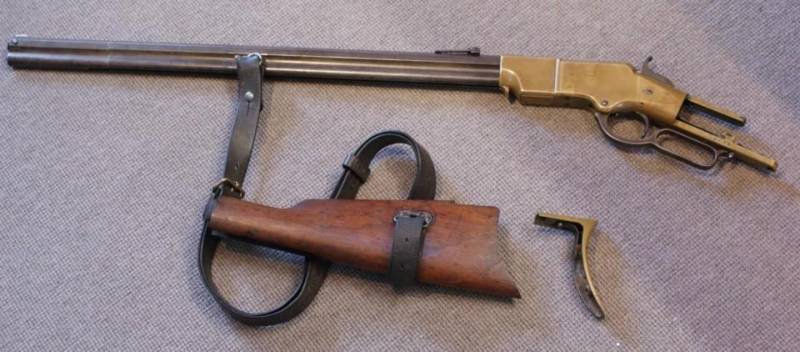
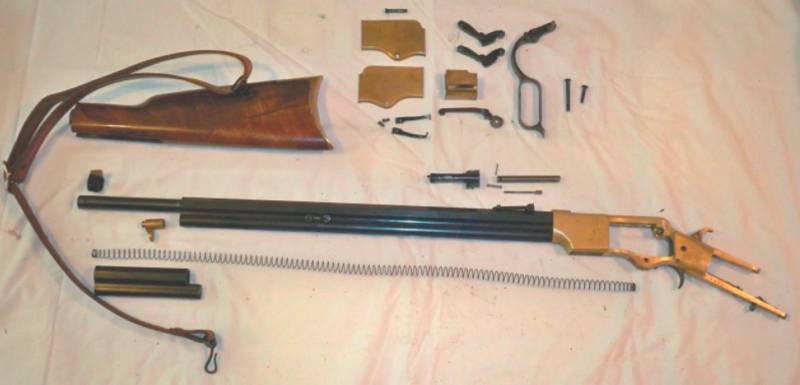
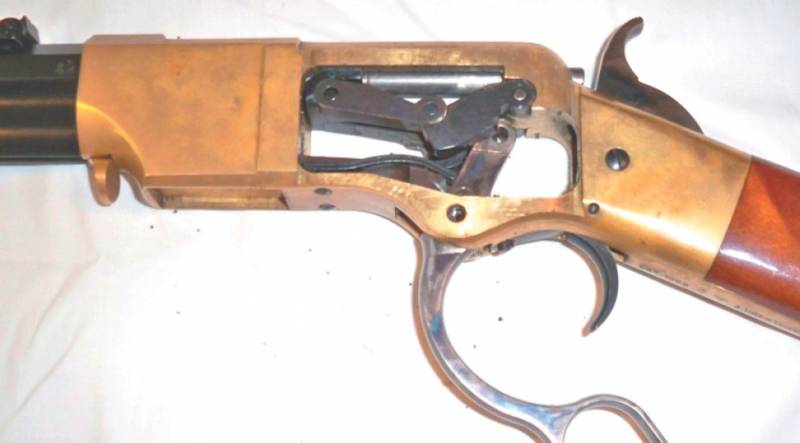
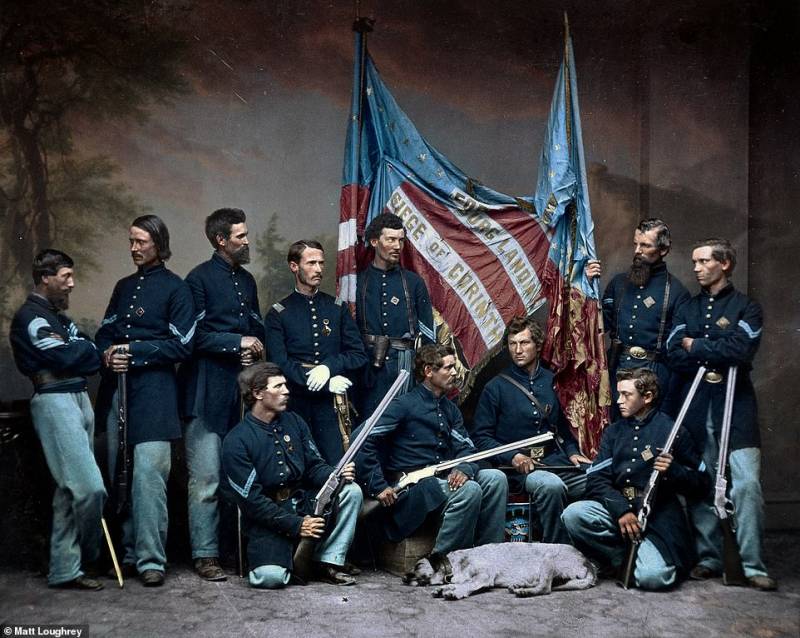
Information